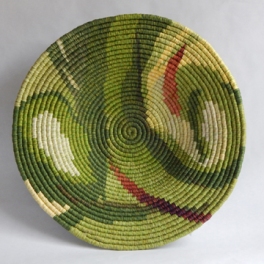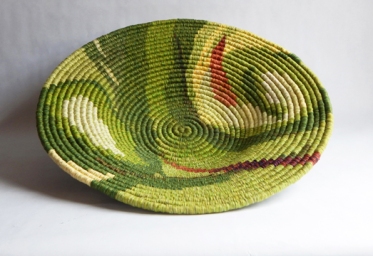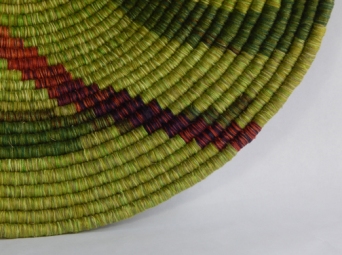It’s hard to look at a piece you’ve worked many hours on and conclude it is a failure. Not necessarily a complete failure, but it has missed the mark you set for it by a significant margin. This is true of the piece I created last year titled, Nascence.
This piece began as a potential commission. I talked back and forth with the representative for a potential client about what would work for the space and what the client was looking for. And, I started making compromises.
This first one was about materials. Now, I have been doing coiled basketry for more than thirty years. I know my materials, what they can do and what they can’t. And I’ve developed techniques which work well with the materials I choose to use, the most important of which is that I always use two strands of core material side-by-side to give my vessels stability and to facilitate the positioning of each row to create the shape of vessel I want. Using one strand of core will not do that.
But, the client wanted something that was large and less than 2 inches deep and they wanted it soon. Starry-eyed about this possible commission for three large pieces in a public space, I compromised and said I could use larger core material and only one strand so that the vessel wouldn’t be too thick. Using my standard quarter-inch core material creates a thickness of one-half inch. Using a thicker core—I had decided on three-eighths of an inch—would have created a core of three-quarters of an inch, almost half the depth of the proposed vessels which have meant a very shallow curve to the vessel. So, I compromised to speed up the work. Working slowly is one reason I work in fiber—it’s an essential part of the process for me and so speeding up worked against not only my artistic mindset, but compromised my creative process. I couldn’t make good decisions about this piece because I was hurrying.
Then there was my second mistake. When I design a new piece, there is some sort of inspirational moment, whether it’s a yarn I like, a color, a phrase of music—there’s always something that excites me and makes me want to create a new piece. Here, the inspiration was an external request for a specific style of piece, in a specific colorway, and a specific size. I compromised my design process to fit the client’s wishes. Or at least, I tried to.
In the end, they decided to use someone else’s work. Just as well. I couldn’t have produced one piece, let alone three, in the time allotted.
But, I pressed on with the pieces anyway. That was my third mistake.
I had an upcoming exhibition deadline and, again, ego got in my way. I decided I would do this larger piece, larger than I’d ever attempted and I would do it using the new, thicker core material I’d never used before. But, instead of listening to my inner voice and using two strands as I should have, I pressed on using just one. And, I decided to use the sketches I had made for the potential commission—just as they were, without critique or rework. Just Make It!
The result was useful but painful.
Is it a good piece? I’d give it a B minus at best.
Am I happy with it? No. Oh, there are some areas in the piece that turned out well but overall the design is awkward and weak and the color gradations aren’t as good as I’d like—some places they’re good, others not so much.
Was it worthwhile? Yes. Even after more than 30 years, you can still relearn things. Like: stick with what you’re good at. Pay attention to your materials. Most importantly: Listen when you inner voice says, Stop! And rethink what you’re doing here.
Commissions aren’t bad. You just have to approach them with a strong sense of what your work is about and make sure they want what you do. Remaking yourself and your work into something that isn’t yours is never a good idea.
Experimentation is essential to growth as an artist. It is very important as an artist to stretch yourself, try new materials, and try new ideas. Failure isn’t all bad. There is success in failure. Because, you always learn something that you can apply to your next piece, or the piece after that.
But, it is also important to do this as part of your studio practice with no thought about the outcome and especially without planning to use the piece for an exhibition or a commission. If it turns out well, OK. Show it in public. If not, you’ve learned what you wanted to know and some things you weren’t expecting, but it was within your studio. No expectations; No demands. Just the work.
So, I’m not sorry I made Nascence. I learned three important things:
1-A thicker core material can help with larger pieces but using two strands is always necessary. Also, I used sisal cording which was firmer than the jute I am used to. I thought that would help with stability but it was much harder to work with and much heavier. So, I will try using thicker jute at some point and see how that works.
2-I advanced my understanding of color blending techniques.
3-I wanted to create a spiral which worked against the natural spiral of the coiled vessel. This worked in one area but not the other. I am still interested in exploring this tension but need to do a better job of understanding how to create a spiral against the grain. More work to do in this area.
Here are some images of Nascence. What do you think?




I think it is BEAUTIFUL! Is that the one you brought to Las Cruces last year? I just love it!
LikeLike
Thanks, Joan! Yes, it’s the one I brought to the guild meeting. Maybe I’ll like it better in a few months.
LikeLike
I am a fiber artist-maker of photo/fabric collages…have also made baskets-not coiled. I was shocked at the beauty of this piece. The color selection is outstanding and for me, unusual in a basket(?) It is so striking-hope you have learned to love it. That does happen sometimes.
LikeLike
Thanks, MaryJane! I am learning to like it more. Time does help. I might tweak it a little but I’m leaving it alone right now. I may enter it in a show or two and see what happens.
LikeLike